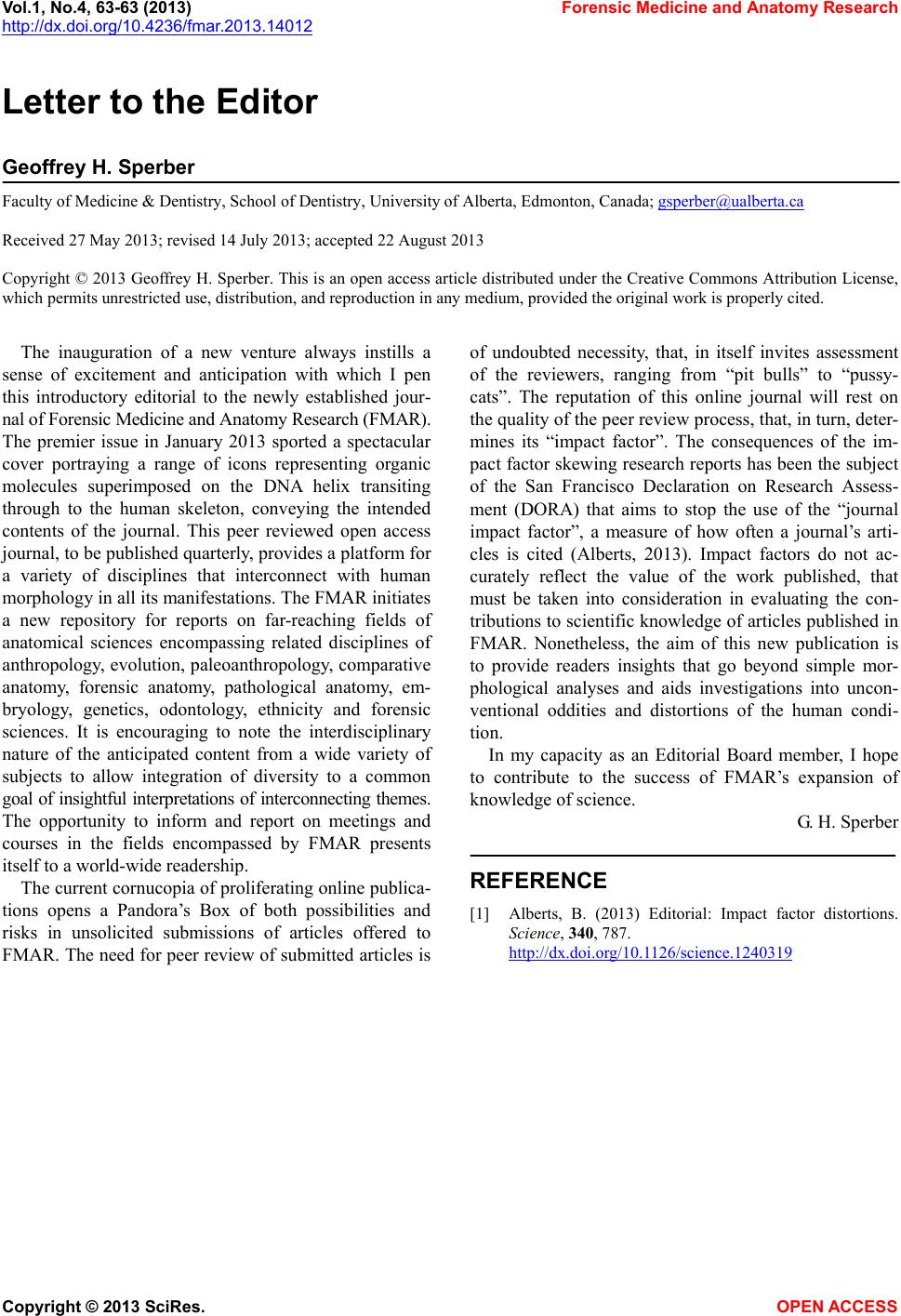
Vol.1, No.4, 63-63 (2013) Forensic Medicine and Anatomy Research
http://dx.doi.org/10.4236/fmar.2013.14012
Letter to the Editor
Geoffrey H. Sperber
Faculty of Medicine & Dentistry, School of Dentistry, University of Alberta, Edmonton, Canada; gsperber@ualberta.ca
Received 27 May 2013; revised 14 July 2013; accepted 22 August 2013
Copyright © 2013 Geoffrey H. Sperber. This is an open access article distributed under the Creative Commons Attribution License,
which permits unrestricted use, distribution, and reproduction in any medium, provided the original work is properly cited.
The inauguration of a new venture always instills a
sense of excitement and anticipation with which I pen
this introductory editorial to the newly established jour-
nal of Forensic Medicine and Anat omy R esearch (FMAR ) .
The premier issue in January 2013 sported a spectacular
cover portraying a range of icons representing organic
molecules superimposed on the DNA helix transiting
through to the human skeleton, conveying the intended
contents of the journal. This peer reviewed open access
journal, to be published quarterly, provides a platform for
a variety of disciplines that interconnect with human
morphology in all its manifestations. The FMAR initiates
a new repository for reports on far-reaching fields of
anatomical sciences encompassing related disciplines of
anthropology, evolution, paleoanthropology, comparative
anatomy, forensic anatomy, pathological anatomy, em-
bryology, genetics, odontology, ethnicity and forensic
sciences. It is encouraging to note the interdisciplinary
nature of the anticipated content from a wide variety of
subjects to allow integration of diversity to a common
goal of insightful interpretations of interconnecting themes.
The opportunity to inform and report on meetings and
courses in the fields encompassed by FMAR presents
itself to a world-wide readership.
The current cornucopia of proliferating online publica-
tions opens a Pandora’s Box of both possibilities and
risks in unsolicited submissions of articles offered to
FMAR. The need for peer review of submitted articles is
of undoubted necessity, that, in itself invites assessment
of the reviewers, ranging from “pit bulls” to “pussy-
cats”. The reputation of this online journal will rest on
the quality of the peer review process, that, in turn, de ter-
mines its “impact factor”. The consequences of the im-
pact factor skewing research repor ts has been the su bject
of the San Francisco Declaration on Research Assess-
ment (DORA) that aims to stop the use of the “journal
impact factor”, a measure of how often a journal’s arti-
cles is cited (Alberts, 2013). Impact factors do not ac-
curately reflect the value of the work published, that
must be taken into consideration in evaluating the con-
tributions to scientific knowledg e of articles published in
FMAR. Nonetheless, the aim of this new publication is
to provide readers insights that go beyond simple mor-
phological analyses and aids investigations into uncon-
ventional oddities and distortions of the human condi-
tion.
In my capacity as an Editorial Board member, I hope
to contribute to the success of FMAR’s expansion of
knowledge of science. G. H. Sperber
REFERENCE
[1] Alberts, B. (2013) Editorial: Impact factor distortions.
Science, 340, 787.
http://dx.doi.org/10.1126/science.1240319
Copyright © 2013 SciRes. OPEN ACCESS